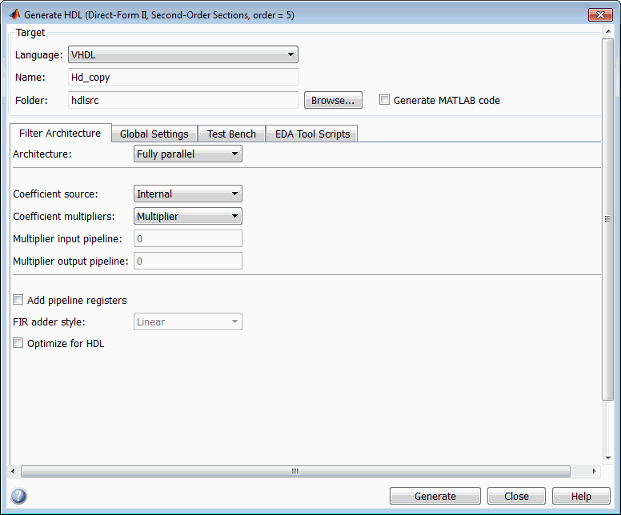Programmable Filter Coefficients for IIR Filters
By default, the coder obtains filter coefficients from a filter object and hard-codes them into the generated code. An HDL filter realization generated in this way cannot be used with a different set of coefficients.
For IIR filters, the coder provides UI options and corresponding command-line properties that let you:
Generate an interface for loading coefficients from memory. Coefficients stored in memory are called programmable coefficients.
Test the interface.
To use programmable coefficients, a port interface (referred to as a processor interface) is generated for the filter entity or module. Coefficient loading is assumed to be under the control of a microprocessor that is external to the generated filter. The filter uses the loaded coefficients for processing input samples.
These IIR filter types support programmable filter coefficients.
Second-order section (SOS) infinite impulse response (IIR) Direct Form I
SOS IIR Direct Form I transposed
SOS IIR Direct Form II
SOS IIR Direct Form II transposed
Limitations
Programmable filter coefficients are supported for IIR filters with fully parallel architectures only.
The generated interface assumes that the coefficients are stored in a register file.
When you generate a processor interface for an IIR filter, the
OptimizeScaleValuesproperty must be between1and0. For example:Check that the filter still has the desired response, using thefilt.OptimizeScaleValues = 0
fvtoolandfilter, commands. Disablingfilt.OptimizeScaleValuesmay add quantization at section inputs and outputs.
You can also generate a processor interface for loading FIR filter coefficients.Specifying Memory for Programmable Coefficients for further information.
Generate a Processor Interface for a Programmable IIR Filter
You can specify a processor interface using the Coefficient source menu on the Generate HDL tool.
The Coefficient source list on the Generate HDL tool lets you select whether coefficients are obtained from the filter object and hard-coded (
Internal), or from memory (Processor interface). The default isInternal.The corresponding command-line property is
CoefficientSource.
The Coefficient stimulus option on the Test Bench pane of the Generate HDL tool specifies how the test bench tests the generated memory interface.
The corresponding command-line property is
TestBenchCoeffStimulus.
Generating a Test Bench for Programmable IIR Coefficients
This section describes how to use the TestBenchCoeffStimulus property to specify how the test bench drives the
coefficient ports. You can also use the Coefficient stimulus option for
this purpose.
When a coefficient memory interface has been generated for a filter, the coefficient
ports have associated test vectors. The TestbenchCoeffStimulus property
determines how the test bench drives the coefficient ports.
The TestBenchStimulus
property determines the filter input stimuli.
The TestbenchCoeffStimulus specified the source of coefficients used
for the test bench. The valid values for TestbenchCoeffStimulus
are:
[]: Empty vector. (default)When the value of
TestbenchCoeffStimulusis an empty vector, the test bench loads the coefficients from the filter object, and then forces the input stimuli. This test shows the response to the input stimuli and verifies that the interface writes one set of coefficients into the memory without encountering an error.A cell array containing these elements:
New_filt.ScaleValues: column vector of scale values for the IIR filterNew_filt.sosMatrix: second-order section (SOS) matrix for the IIR filter
You can specify the elements of the cell array in these forms:
{New_filt.ScaleValues,New_filt.sosMatrix}{New_filt.ScaleValues;New_filt.sosMatrix}{New_filt.sosMatrix,New_filt.ScaleValues}{New_filt.sosMatrix;New_filt.ScaleValues}{New_filt.ScaleValues}{New_filt.sosMatrix}
In this case, the filter processes the input stimuli twice. First, the test bench loads the coefficients from the filter object and forces the input stimuli to show the response. Then, the filter loads the set of coefficients specified in the
TestbenchCoeffStimuluscell array, and shows processes the same input stimuli again. The internal states of the filter, as set by the first run of the input stimulus, are retained. The test bench verifies that the interface writes two different sets of coefficients into the register file. The test bench also provides an example of how the memory interface can be used to program the filter with different sets of coefficients.If you omit
New_filt.ScaleValues, the test bench uses the scale values loaded from the filter object twice. Likewise, if you omitNew_filt.sosMatrix, the test bench uses the SOS matrix loaded from the filter object twice.
Addressing Scheme for Loading IIR Coefficients
This table gives the address generation scheme for the write_address
port when loading IIR coefficients into memory. This addressing scheme allows the different
types of coefficients (scale values, numerator coefficients, and denominator coefficients)
to be loaded via a single port (coeffs_in).
Each type of coefficient has the same word length, but can have different fractional lengths.
The address for each coefficient is divided into two fields:
Section address: Width is
ceil(log2N)bits, whereNis the number of sections.Coefficient address: Width is three bits.
The total width of the write_address port is therefore
ceil(log2N) + 3bits.
| Section Address | Coefficient Address | Description |
|---|---|---|
S S ... S | 000 | Section scale value |
S S ... S | 001 | Numerator coefficient: b1 |
S S ... S | 010 | Numerator coefficient: b2 |
S S ... S | 011 | Numerator coefficient: b3 |
S S ... S | 100 | Denominator coefficient: a2 |
S S ... S | 101 | Denominator coefficient: a3 (if order = 2; otherwise
unused) |
S S ... S | 110 | Unused |
0 0 ... 0 | 111 | Last scale value |
